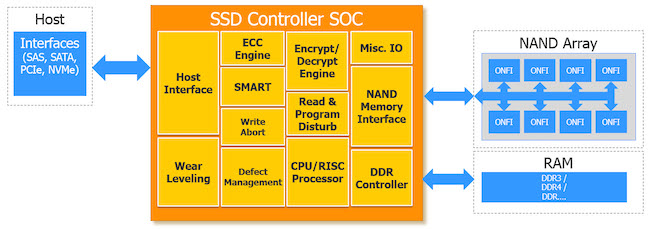The SSD memory revolution
One interesting aspect of my role as an emulation product manager is that I get to mingle with and learn from some of the best experts across multiple industries and technologies — from mobile to networking, automotive to IoT, and multimedia to enterprise storage.
It was at one of the major storage events, the IEEE International Memory Workshop (IMW), that I was able to do just that and learn about new advances in solid state drive (SSD) technology. There were some great presentations from key leaders in the storage industry at IMW, and what struck me was the huge amount of emphasis and information related to memory technology research and how it will improve the performances of SSDs in terms of lower latencies, higher IOPS, and higher bandwidths. In addition, the use of higher densities of NAND flash in SSDs benefits the environment, delivering lower power consumption and thereby improving our daily lives.
I got to hear a lot about the latest updates to flash, such as storage class memory. This employs 3D-XPoint technology pioneered at Micron and Intel. I also heard about advances in non-volatile memories, such as resistive random-access memory (RRAM) and non-volatile dual in-line memory module (NV-DIMM). These advances respond to the needs of performance-hungry applications — for instance for finance and data analytics — that in-turn represent a big opportunity for businesses based around cloud data servers and enterprise storage.
Of course, there was a great emphasis at the IMW workshop on the device physics requirements and improvements being made in flash cell developments, including different architectures and topologies – particularly in 3D – that showed how much progress has been made since the first 3D NAND flash memories came on the scene in 2007. This has led to more cost-effective architectures, such as vertically-stacked 3D NAND, and helped to fuel the explosion in the SSD drive market happening right now.
SSD requirements for enterprise storage design
As you can see, it is an exciting time for the SSD business with lots of opportunities for growth. In the emulation solutions group here at Mentor Graphics, we also see an explosion in requirements from the enterprise storage market, and that challenges us to deliver verification solutions for the leading-edge vendors in SSD.
Fortunately, our expertise has grown over several years’ involvement in this industry. We continue to develop new and novel techniques for addressing those needs, particularly with in-circuit emulation and our virtual solutions, which address multiple markets including SSD and are a game-changer in terms of productivity, performance, and debug for emulation users.
So, it’s clear that the SSD memory revolution is here — and in delivering verification solutions, we are ready!
To learn more about the rise of SSD technology and Mentor’s emulation solutions for storage system designs, check out the new whitepaper Veloce Delivers Best of ICE and Virtual Emulation to the SSD Storage Market.
 Richard Pugh is the Product Marketing Manager for Mentor's Emulation Division. He holds an MSc in Computer Science and Electronics from University College London.
Richard Pugh is the Product Marketing Manager for Mentor's Emulation Division. He holds an MSc in Computer Science and Electronics from University College London. 


